Numerical Simulation of Gas Production and Reservoir Stability during CO2 Exchange in Natural Gas Hydrate Reservoir
Abstract
1. Introduction
2. THMC Model and Solution Approach
2.1. Hydrate Reaction Kinetic Model
2.2. Mass Balance Equations
2.3. Energy Balance Equation
2.4. Geomechanics Equation
2.5. Dynamic Model of NGH Reservoir Thermophysical Parameters
2.6. Solution Approach
3. Results and Discussions
3.1. Analysis of Fluid Production
3.2. Evolution of P, T, and Sh
3.3. Effect of CO2 Exchange on NGH Reservoir Stability
4. Conclusions
- (a)
- A coupled THMC numerical model was developed in this study for the description of the complex phase change behavior, the gas-water two-phase flow, heat transfer, and formation deformation associated with NGH field-scale production;
- (b)
- The simulation results suggested that the injection of CO2 promotes the dissociation of NGH compared with depressurization only. The cumulative production of gas and water increased by 27.88% and 2.90%, respectively based on 2000 days of production simulation;
- (c)
- In Case A (depressurization only), NGH dissociation is symmetric and propagates outward based on the center of production well. While in Case B (depressurization coupled with CO2 exchange), the majority of NGH dissociation occurs in the region between the injection well and the production well;
- (d)
- NGH reservoir subsidence propagates outward based on the center of the production well in both cases. The maximum subsidence occurs at the interface of the overburden and NGH layer near the production well. The maximum uplift occurs at the interface of the underburden and NGH layer at the production well;
- (e)
- The subsidence of the NGH reservoir is less in Case B (depressurization coupled with CO2 exchange) compared with that of Case A (depressurization only) at the same cumulative gas production. The results suggest CO2 exchange in the NGH reservoirs alleviates the issue of reservoir subsidence during production and maintains good reservoir stability.
Author Contributions
Funding
Data Availability Statement
Conflicts of Interest
References
- Chong, Z.R.; Yang, S.H.B.; Babu, P.; Linga, P.; Li, X.-S. Review of natural gas hydrates as an energy resource: Prospects and challenges. Appl. Energy 2016, 162, 1633–1652. [Google Scholar] [CrossRef]
- Yin, Z.; Chong, Z.R.; Tan, H.K.; Linga, P. Review of gas hydrate dissociation kinetic models for energy recovery. J. Nat. Gas Sci. Eng. 2016, 35, 1362–1387. [Google Scholar] [CrossRef]
- Qiu, S.; Wang, G. Effects of Reservoir Parameters on Separation Behaviors of the Spiral Separator for Purifying Natural Gas Hydrate. Energies 2020, 13, 5346. [Google Scholar] [CrossRef]
- Wang, Y.; Ning, Y.; Wang, Y. Fractional Time Derivative Seismic Wave Equation Modeling for Natural Gas Hydrate. Energies 2020, 13, 5901. [Google Scholar] [CrossRef]
- Ren, J.; Liu, X.; Niu, M.; Yin, Z. Effect of sodium montmorillonite clay on the kinetics of CH4 hydrate—Implication for energy recovery. Chem. Eng. J. 2022, 437, 135368. [Google Scholar] [CrossRef]
- Lee, T.; Lee, J.Y.; Ahn, T.; Son, H.A. Numerical Simulation of Gas Hydrate Production Using the Cyclic Depressurization Method in the Ulleung Basin of the Korea East Sea. Appl. Sci. 2021, 11, 9748. [Google Scholar] [CrossRef]
- Zhou, S.; Chen, W.; Li, Q.; Zhou, J.; Shi, H. Research on the solid fluidization well testing and production for shallow non-diagenetic natural gas hydrate in deep water area. China Offshore Oil Gas 2017, 29, 1–8. [Google Scholar]
- Qin, X.; Lu, C.; Wang, P.; Liang, Q. Hydrate phase transition and seepage mechanism during natural gas hydrates production tests in the South China Sea: A review and prospect. China Geol. 2022, 2, 201–217. [Google Scholar] [CrossRef]
- Zhou, S.; Li, Q.; Lv, X.; Pang, W.; Fu, Q. Thinking and suggestions on research direction of natural gas hydrate development. China Offshore Oil Gas 2019, 31, 1–8. [Google Scholar]
- Cao, X.; Wang, H.; Yang, K.; Wu, S.; Chen, Q.; Bian, J. Hydrate-based CO2 sequestration technology: Feasibilities, mechanisms, influencing factors, and applications. J. Pet. Sci. Eng. 2022, 2022, 111121. [Google Scholar] [CrossRef]
- Song, Y.; Wang, S.; Cheng, Z.; Huang, M.; Zhang, Y.; Zheng, J.; Jiang, L.; Liu, Y. Dependence of the hydrate-based CO2 storage process on the hydrate reservoir environment in high-efficiency storage methods. Chem. Eng. J. 2021, 415, 128937. [Google Scholar] [CrossRef]
- Makogon, Y.F.; Holditch, S.A.; Makogon, T.Y. Russian field illustrates gas-hydrate production. Oil Gas J. 2005, 103, 43–47. [Google Scholar]
- Grover, T.; Holditch, S.A.; Moridis, G. Analysis of Reservoir Performance of Messoyakha Gas Hydrate Field. In Proceedings of the SPE Annual Technical Conference and Exhibition, Denver, USA, 21–24 September 2008. SPE-114375-MS. [Google Scholar]
- Makogon, Y.F.; Omelchenko, R.Y. Commercial gas production from Messoyakha deposit in hydrate conditions. J. Nat. Gas Sci. Eng. 2013, 11, 1–6. [Google Scholar] [CrossRef]
- Ye, H.; Wu, X.; Li, D. Numerical Simulation of Natural Gas Hydrate Exploitation in Complex Structure Wells: Productivity Improvement Analysis. Mathematics 2021, 9, 2184. [Google Scholar] [CrossRef]
- Li, L.; Li, X.; Wang, Y.; Qin, C.; Li, B.; Luo, Y.; Feng, J. Investigating the Interaction Effects between Reservoir Deformation and Hydrate Dissociation in Hydrate-Bearing Sediment by Depressurization Method. Energies 2021, 14, 548. [Google Scholar] [CrossRef]
- Kurihara, M.; Sato, A.; Funatsu, K.; Ouchi, H.; Yamamoto, K.; Numasawa, M.; Ebinuma, T.; Narita, H.; Masuda, Y.; Dallimore, S.R.; et al. Analysis of Production Data for 2007/2008 Mallik Gas Hydrate Production Tests in Canada. In Proceedings of the International Oil and Gas Conference and Exhibition in China, Beijing, China, 8–10 June 2010. SPE-132155-MS. [Google Scholar]
- Fujii, T.; Takayama, T.; Nakamizu, M.; Yamamoto, K.; Dallimore, S.R.; Mwenifumbo, J.; Wright, J.F.; Kurihara, M.; Sato, A.; Al-Jubori, A. Wire-line logging analysis of the 2007 JOGMEC/NRCAN/AURORA Mallik gas hydrate production test well. In Proceedings of the 6th International Conference on Gas Hydrates (ICGH 2008), Vancouver, BC, Canada, 6–10 July 2008. [Google Scholar]
- Zhang, J.; Liu, X.; Chen, D.; Yin, Z. An investigation on the permeability of hydrate-bearing sediments based on pore-scale CFD simulation. Int. J. Heat Mass Transf. 2022, 192, 122901. [Google Scholar] [CrossRef]
- Schoderbek, D.; Martin, K.L.; Howard, J.; Silpngarmlert, S.; Hester, K. North slope hydrate fieldtrial: CO2/CH4 exchange. In Proceedings of the OTC Arctic Technology Conference, Houston, TX, USA, 3–5 December 2012. OTC-23725-MS. [Google Scholar]
- Zhu, Y.; Zhang, Y.; Sun, Z. Overview on permafrost gas hydrate exploration in China. In Proceedings of the 8th International Conference on Gas Hydrate, Beijing, China, 28 July–1 August 2014. [Google Scholar]
- Zhu, Y.; Pang, S.; Wang, P.; Zhang, S.; Xiao, R. A review of the resource potentials and test productions of natural gas hydrates in China. Sediment. Geol. Tethyan Geol. 2021, 41, 524–535. [Google Scholar]
- Yamamoto, K. Methane hydrate offshore production test in the eastern Nankai Trough: A milestone on the path to real energy resource. In Proceedings of the 8th International Conference on Gas Hydrate, Beijing, China, 28 July–1 August 2014. [Google Scholar]
- Konno, Y.; Fujii, T.; Sato, A.; Akamine, K.; Naiki, M.; Masuda, Y.; Yamamoto, K.; Nagao, J. Key findings of the world’s first offshore methane hydrate production test off the coast of Japan: Toward future commercial production. Energy Fuels 2017, 31, 2607–2616. [Google Scholar] [CrossRef]
- Yamamoto, K.; Wang, X.-X.; Tamaki, M.; Suzuki, K. The second offshore production of methane hydrate in the Nankai Trough and gas production behavior from a heterogeneous methane hydrate reservoir. RSC Adv. 2019, 9, 25987–26013. [Google Scholar] [CrossRef] [PubMed]
- Ye, J.-L.; Qin, X.-W.; Qiu, H.-J.; Liang, Q.-Y.; Dong, Y.-F.; Wei, J.-G.; Lu, H.-L.; Lu, J.-A.; Shi, Y.-H.; Zhong, C. Preliminary results of environmental monitoring of the natural gas hydrate production test in the South China Sea. China Geol. 2018, 1, 202–209. [Google Scholar] [CrossRef]
- Ye, J.; Qin, X.; Xie, W.; Lu, H.; Ma, B.; Qiu, H.; Liang, J.; Lu, J.; Kuang, Z.; Lu, C. Main progress of the second gas hydrate trial production in the South China Sea. Geol. China 2020, 47, 557–568. [Google Scholar]
- Lu, H.; Shang, S.; Chen, X.; Qin, X.; Gu, L.; Qiu, H. Research progress and development direction of numerical simulator for natural gas hydrate development. Acta Pet. Sin. 2021, 42, 1516. [Google Scholar]
- Gaddipati, M. Code Comparison of Methane Hydrate Reservoir Simulators Using CMG STARS. Master’s Thesis, West Virginia University, Morgantown, WV, USA, 2008. [Google Scholar]
- Uddin, M.; Coombe, D.; Law, D.; Gunter, B. Numerical studies of gas hydrate formation and decomposition in a geological reservoir. J. Energy Resour. Technol. 2008, 130, 3. [Google Scholar] [CrossRef]
- Anderson, B.J.; Wilder, J.W.; Kurihara, M.; White, M.D.; Moridis, G.J.; Wilson, S.J.; Pooladi-Darvish, M.; Masuda, Y.; Collett, T.S.; Hunter, R. Analysis of modular dynamic formation test results from the Mount Elbert 01 stratigraphic test well, Milne Point Unit, North Slope, Alaska. Marine Pet. Geol. 2008, 28, 2. [Google Scholar]
- Lamedo, M.A.; Provero, D.; Viloria, A.; Yánez, G. Gas production from hydrates dissociation in marine sediments. In Proceedings of the SPE Latin American and Caribbean Petroleum Engineering Conference, Lima, Peru, 1–3 December 2010. SPE-139306-MS. [Google Scholar]
- Reagan, M.T.; Moridis, G.J.; Johnson, J.N.; Pan, L.; Freeman, C.M.; Boyle, K.L.; Keen, N.D.; Husebo, J. Field-scale simulation of production from oceanic gas hydrate deposits. Transp. Porous Media 2015, 108, 151–169. [Google Scholar] [CrossRef]
- Myshakin, E.M.; Gaddipati, M.; Rose, K.; Anderson, B.J. Numerical simulations of depressurization-induced gas production from gas hydrate reservoirs at the Walker Ridge 313 site, northern Gulf of Mexico. Marine Pet. Geol. 2012, 34, 169–185. [Google Scholar] [CrossRef]
- Li, S.; Ding, S.; Wu, D.; Wang, X.; Hao, Y.; Li, Q.; Pang, W. Analysis of stratum subsidence induced by depressurization at an offshore hydrate-bearing sediment. Energy Fuels 2021, 35, 1381–1388. [Google Scholar] [CrossRef]
- Li, S.; Wu, D.; Wang, Z.; Liu, J.; Xie, Y. Numerical simulation of dissociation front of Shenhu hydrate reservoirs by depressurization. Scientia Sinica Phys. Mech. Astron. 2019, 49, 034609. [Google Scholar] [CrossRef]
- Li, S.; Li, S.; Zheng, R.; Li, Q.; Pang, W. Strategies for gas production from Class 2 hydrate accumulations by depressurization. Fuel 2021, 286, 119380. [Google Scholar] [CrossRef]
- CMG. Stars User Guide; Computer Modelling Group Ltd.: Calgary, AB, Canada, 2015. [Google Scholar]
- Li, G. Numerical investigation of CO2 storage in hydrocarbon field using a geomechanical-fluid coupling model. Petroleum 2016, 2, 252–257. [Google Scholar] [CrossRef]
- Al-Mudhafer, W.J.; Zein Al-Abideen, M.J. Comparative evaluation of a heterogeneous light oil reservoir performance: Thermal IOR simulation, bitumen extraction, and associated geomechanical deformation. In Proceedings of the SPE Arctic and Extreme Environments Technical Conference and Exhibition, Moscow, Russia, 15–17 October 2013. [Google Scholar]
- Varre, S.B.; Siriwardane, H.J.; Gondle, R.K.; Bromhal, G.S.; Chandrasekar, V.; Sams, N. Influence of geochemical processes on the geomechanical response of the overburden due to CO2 storage in saline aquifers. Int. J. Greenh. Gas Control 2015, 42, 138–156. [Google Scholar] [CrossRef]
- Lin, T.-K.; Hsieh, B.-Z. Prevention of seabed subsidence of class-1 gas hydrate deposits via CO2-EGR: A numerical study with coupled geomechanics-hydrate reaction-multiphase fluid flow model. Energies 2020, 13, 1579. [Google Scholar] [CrossRef]
- Kim, H.; Bishnoi, P.R.; Heidemann, R.A.; Rizvi, S.S. Kinetics of methane hydrate decomposition. Chem. Eng. Sci. 1987, 42, 1645–1653. [Google Scholar] [CrossRef]
- Clarke, M.A.; Bishnoi, P.R. Measuring and modelling the rate of decomposition of gas hydrates formed from mixtures of methane and ethane. Chem. Eng. Sci. 2001, 56, 4715–4724. [Google Scholar] [CrossRef]
- Kamath, V.A. Study of Heat Transfer Characteristics during Dissociation of Gas Hydrates in Porous Media. Ph.D. Thesis, University of Pittsburgh, Pittsburgh, PA, USA, 1984. [Google Scholar]
- Goel, N. In situ methane hydrate dissociation with carbon dioxide sequestration: Current knowledge and issues. J. Pet. Sci. Eng. 2006, 51, 169–184. [Google Scholar] [CrossRef]
- Tran, D.; Nghiem, L.; Buchanan, L. Aspects of coupling between petroleum reservoir flow and geomechanics. In Proceedings of the 43rd US Rock Mechanics Symposium & 4th US-Canada Rock Mechanics Symposium, Asheville, NC, USA, 28 June–1 July 2009. ARMA-09-089. [Google Scholar]
- Tran, D.; Buchanan, L.; Nghiem, L. Improved gridding technique for coupling geomechanics to reservoir flow. SPE J. 2010, 15, 64–75. [Google Scholar] [CrossRef]
- Aziz, K.; Ramesh, A.; Woo, P. Fourth SPE comparative solution project: Comparison of steam injection simulators. J. Pet. Technology 1987, 39, 1576–1584. [Google Scholar] [CrossRef]
- Ran, Q.-Q.; Li, S.-L. Study on dynamic models of reservoir parameters in the coupled simulation of multiphase flow and reservoir deformation. Pet. Explor. Dev. 1997, 24, 61–65. [Google Scholar]
- Moridis, G.J.; Queiruga, A.F.; Reagan, M.T. Simulation of gas production from multilayered hydrate-bearing media with fully coupled flow, thermal, chemical and geomechanical processes using TOUGH+ Millstone. Part 1: Numerical modeling of hydrates. Transp. Porous Media 2019, 128, 405–430. [Google Scholar] [CrossRef]
- Lin, T.-K. Numerical Simulation Study of CO2 Enhanced Gas Recovery in Class 1 Gas Hydrate Deposits Offshore Southwestern Taiwan. Master’s Thesis, National Cheng Kung University, Tainan, China, 2019. [Google Scholar]
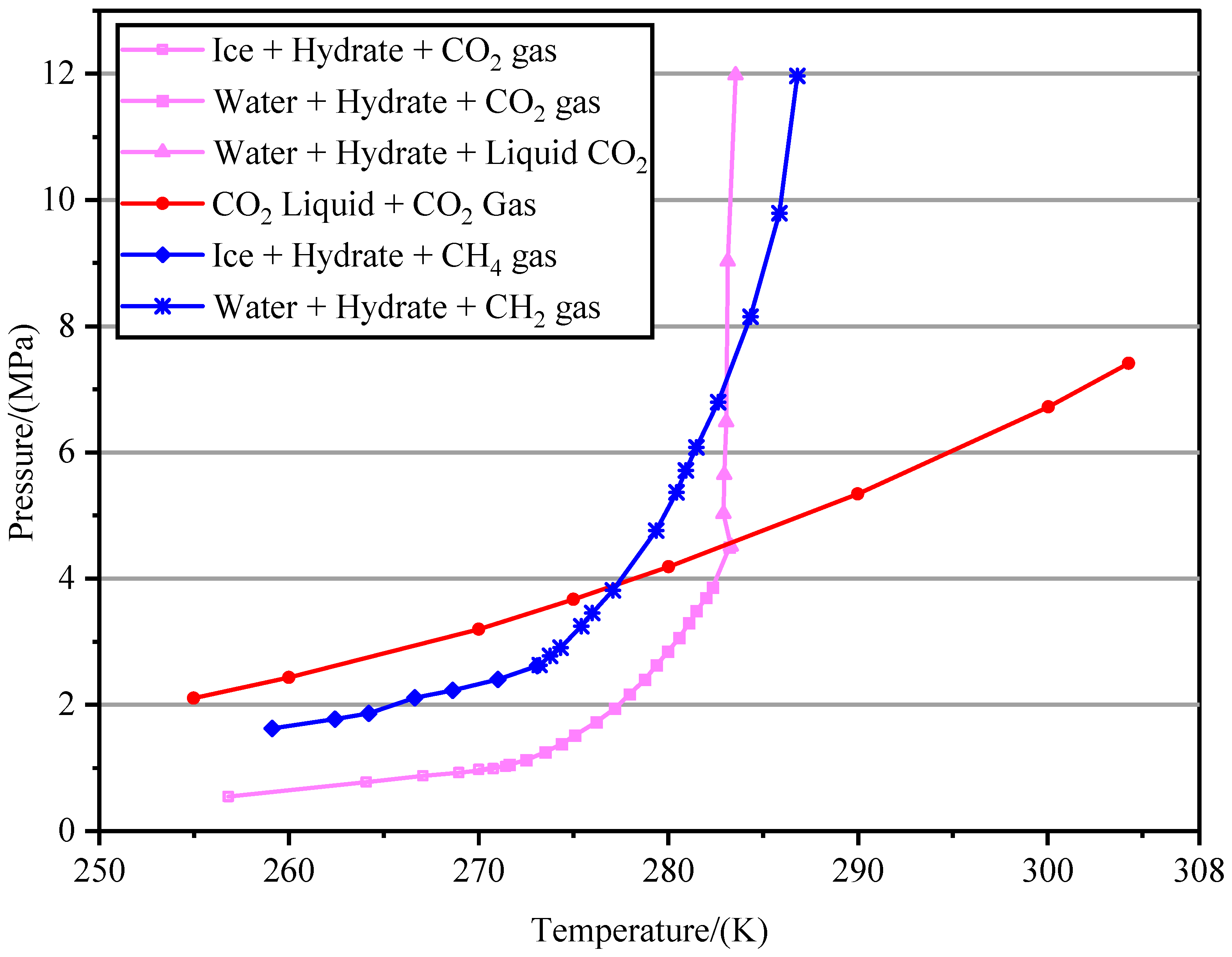

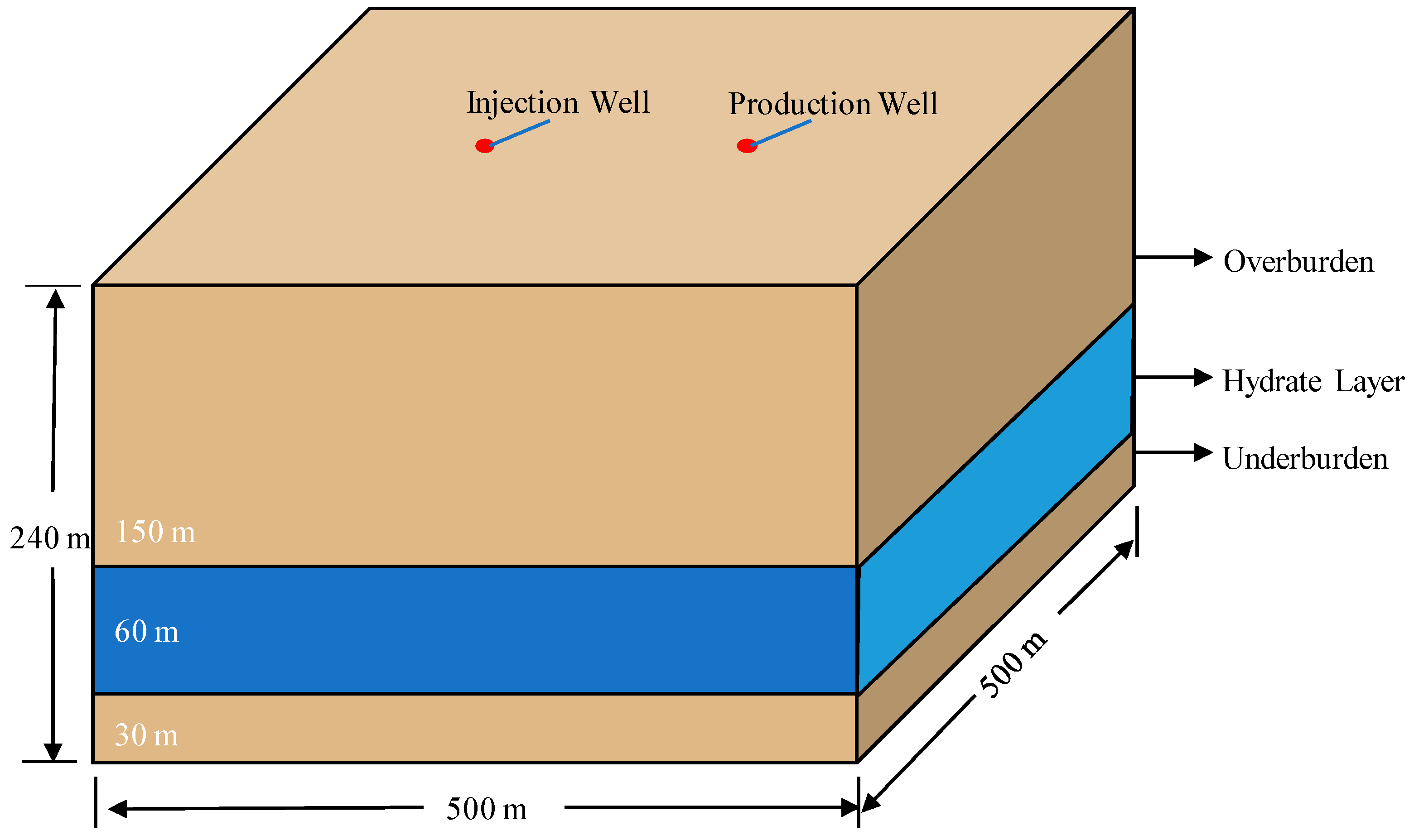
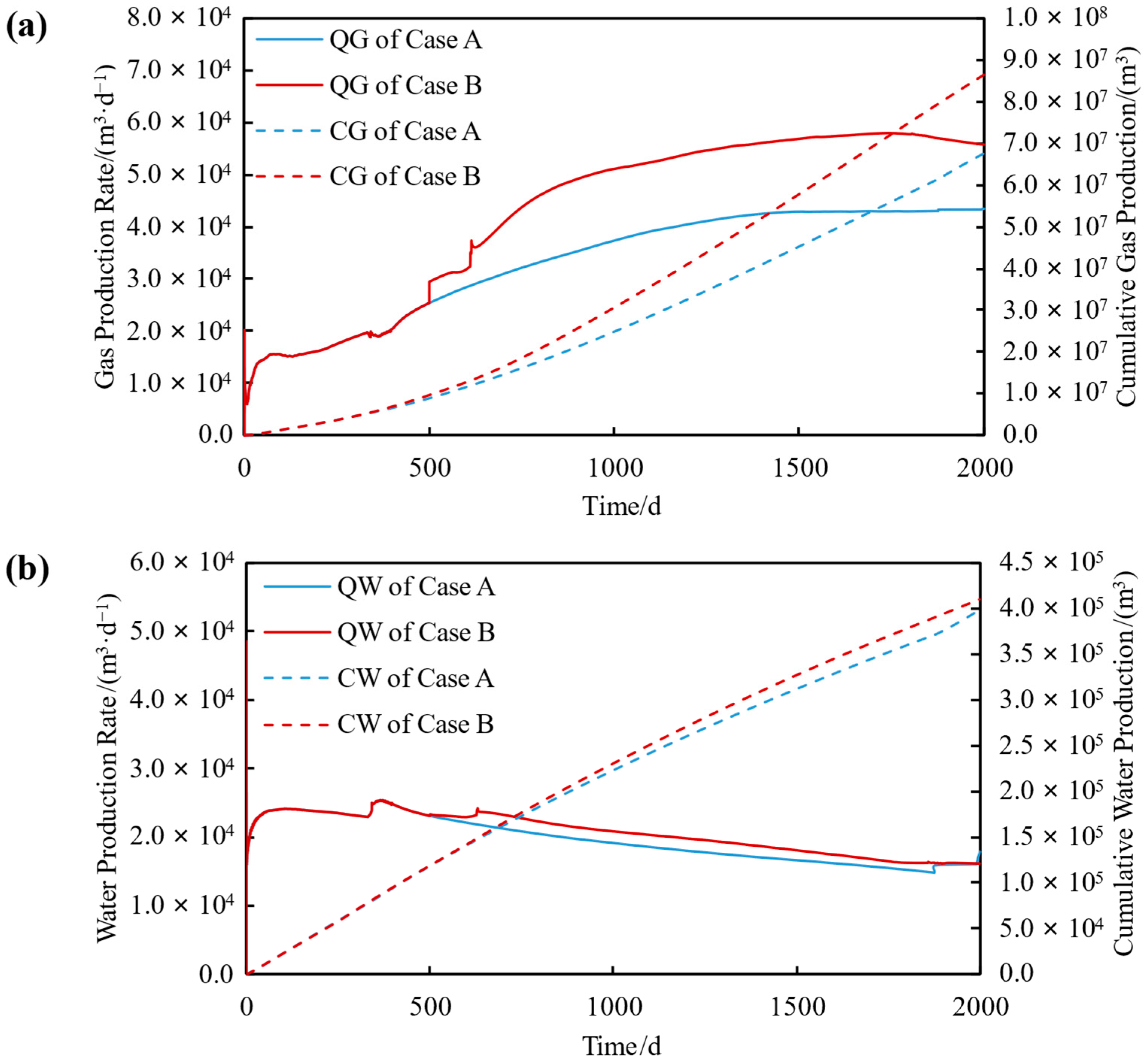
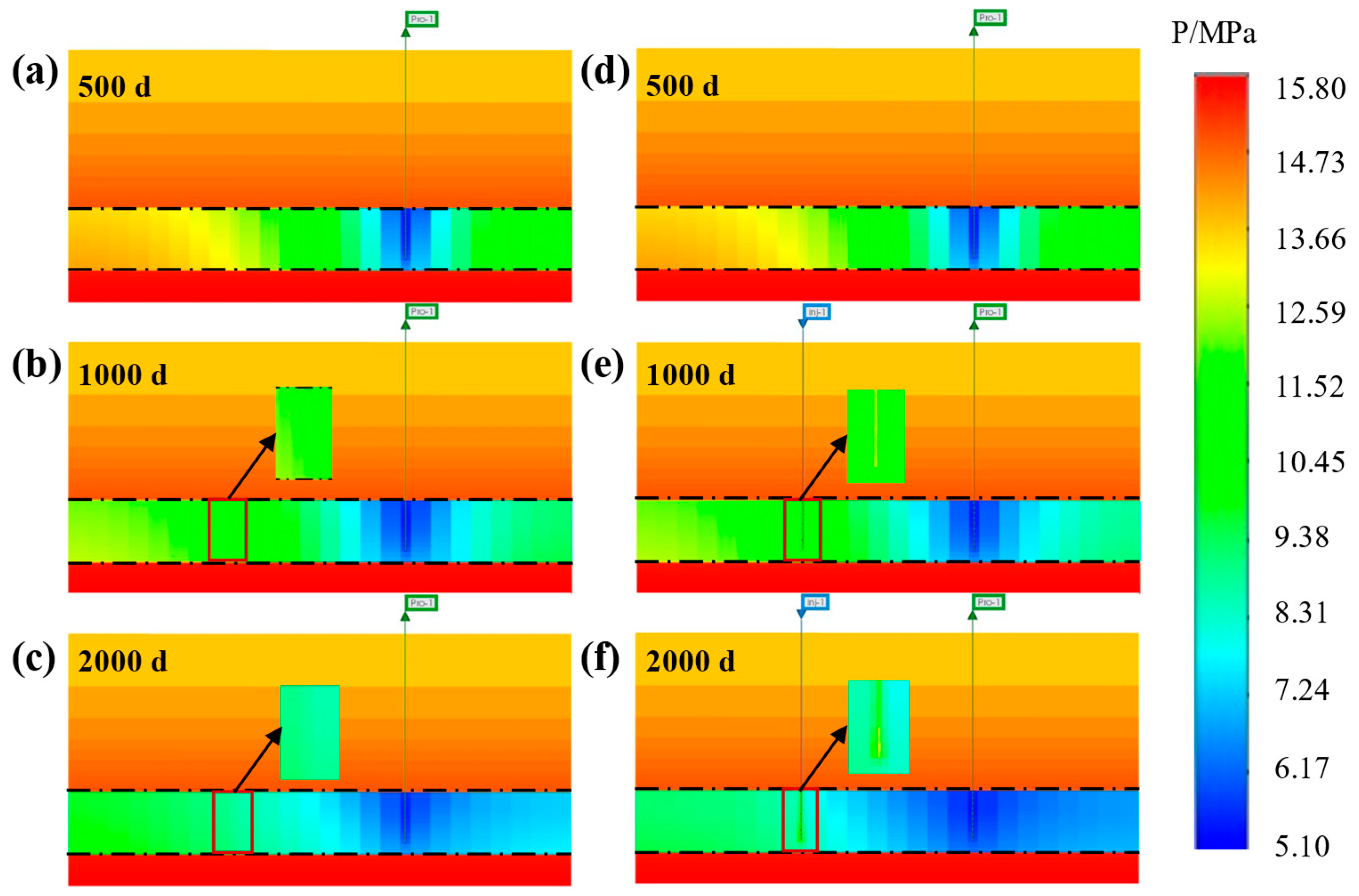
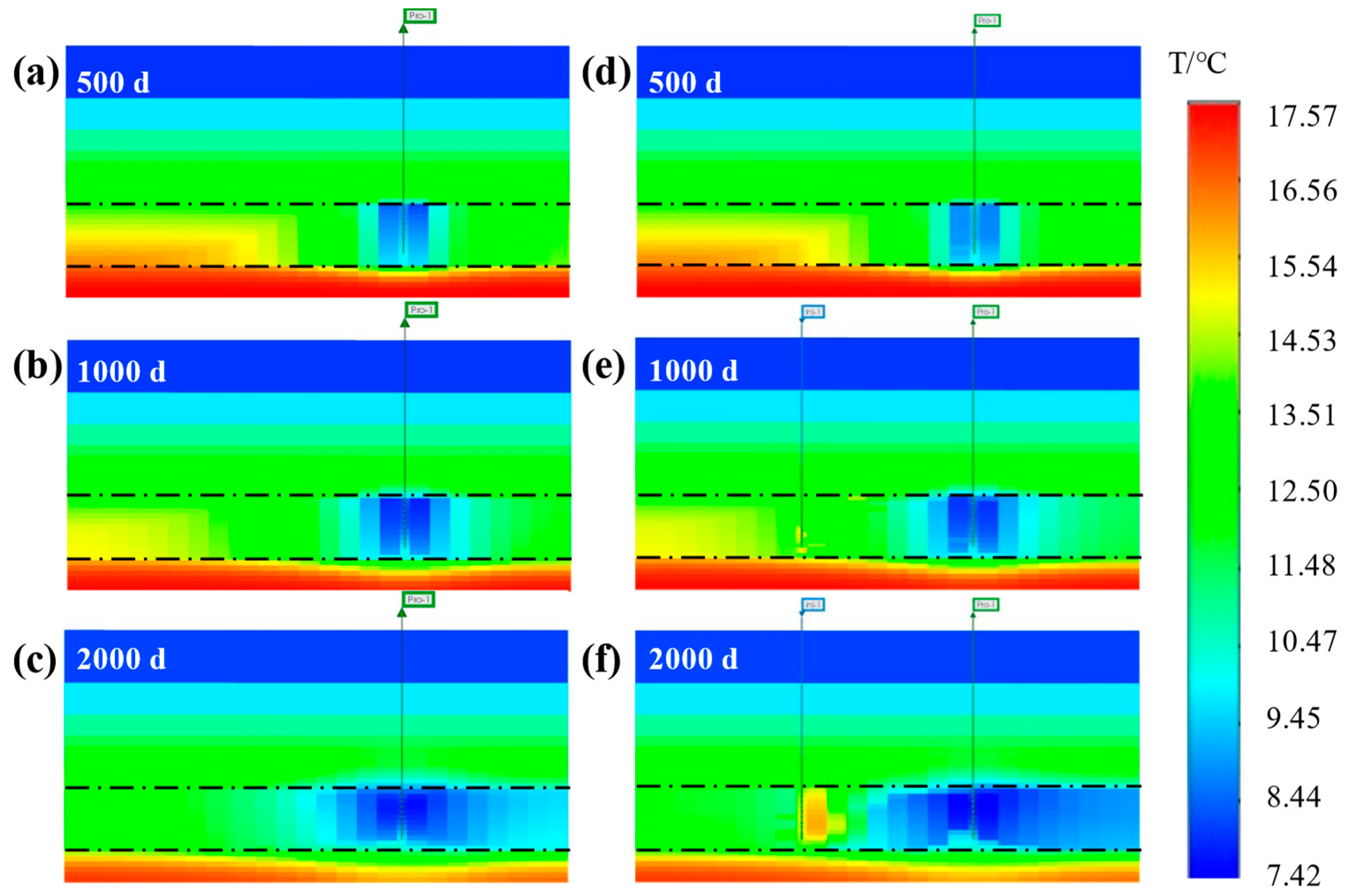
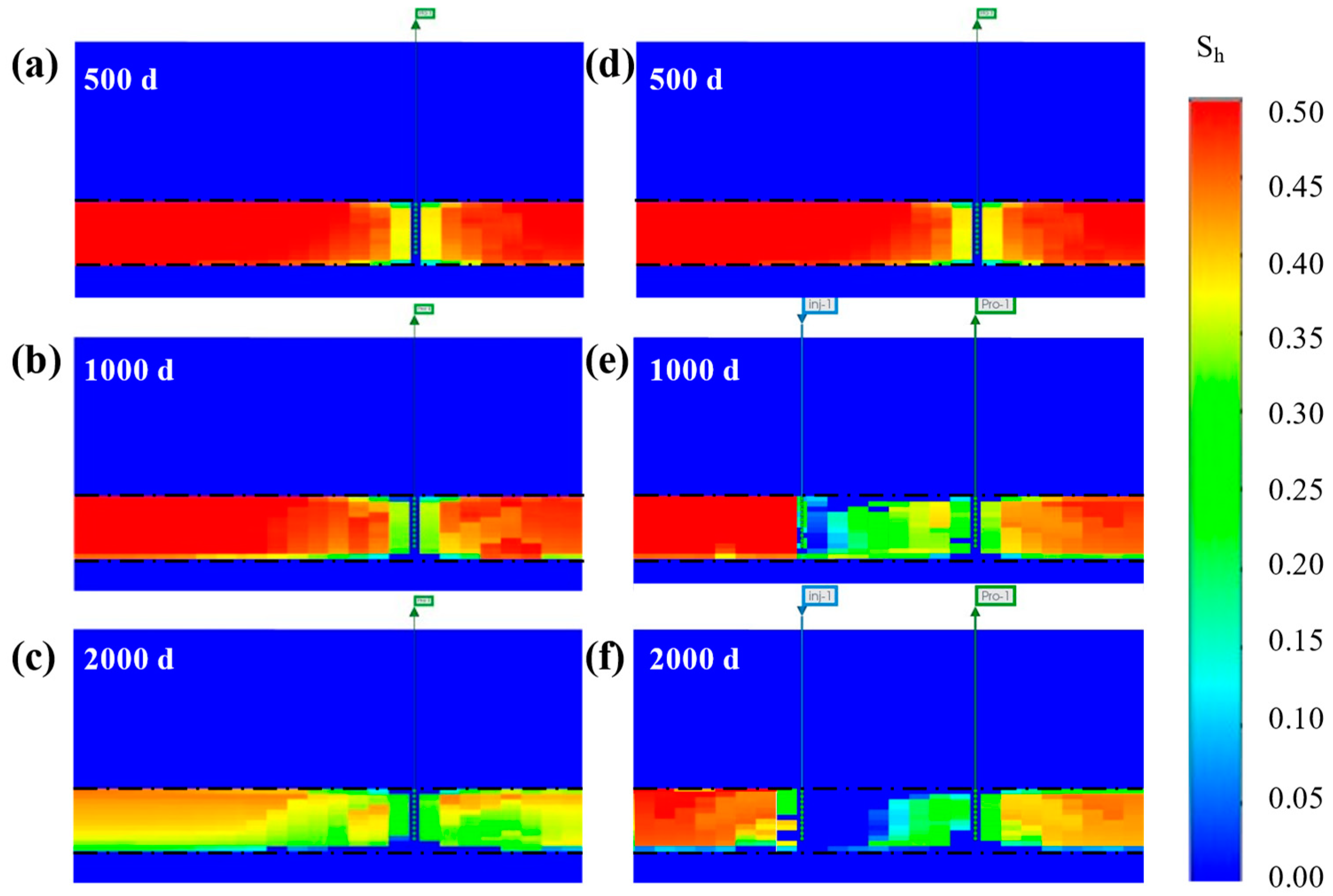

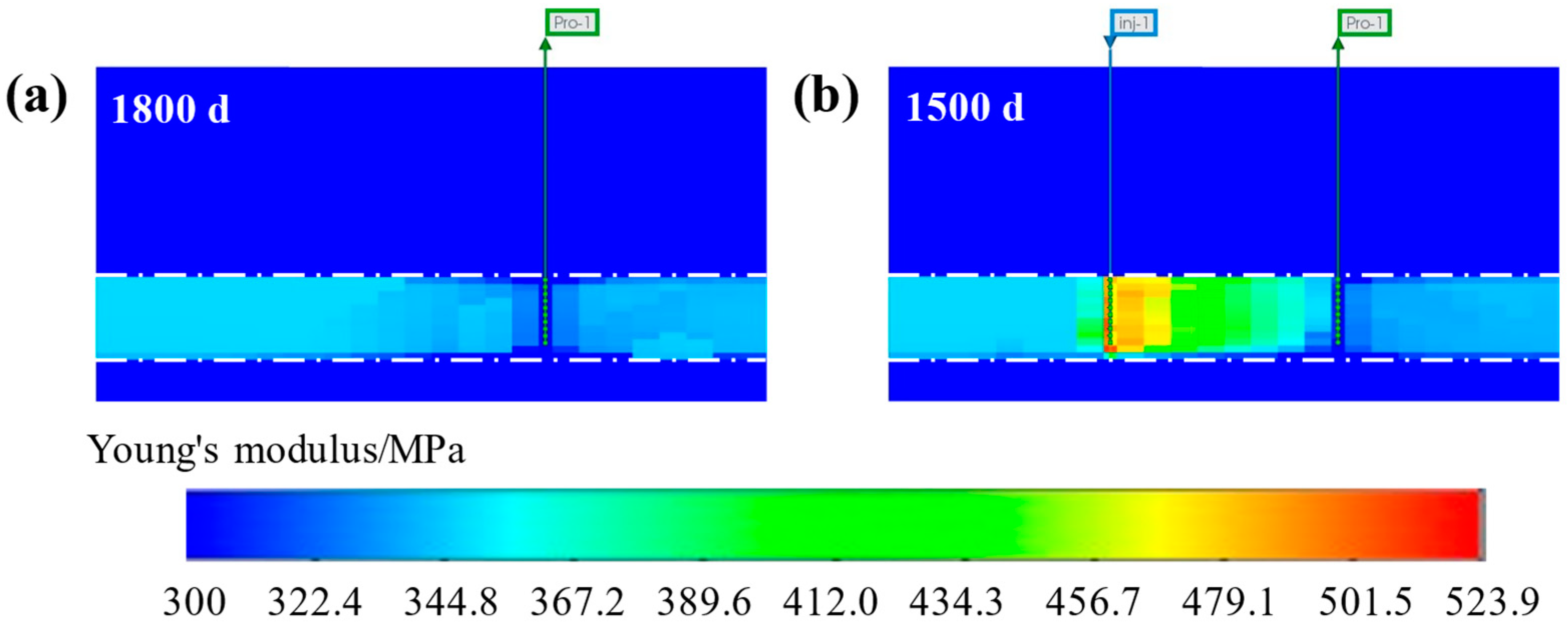
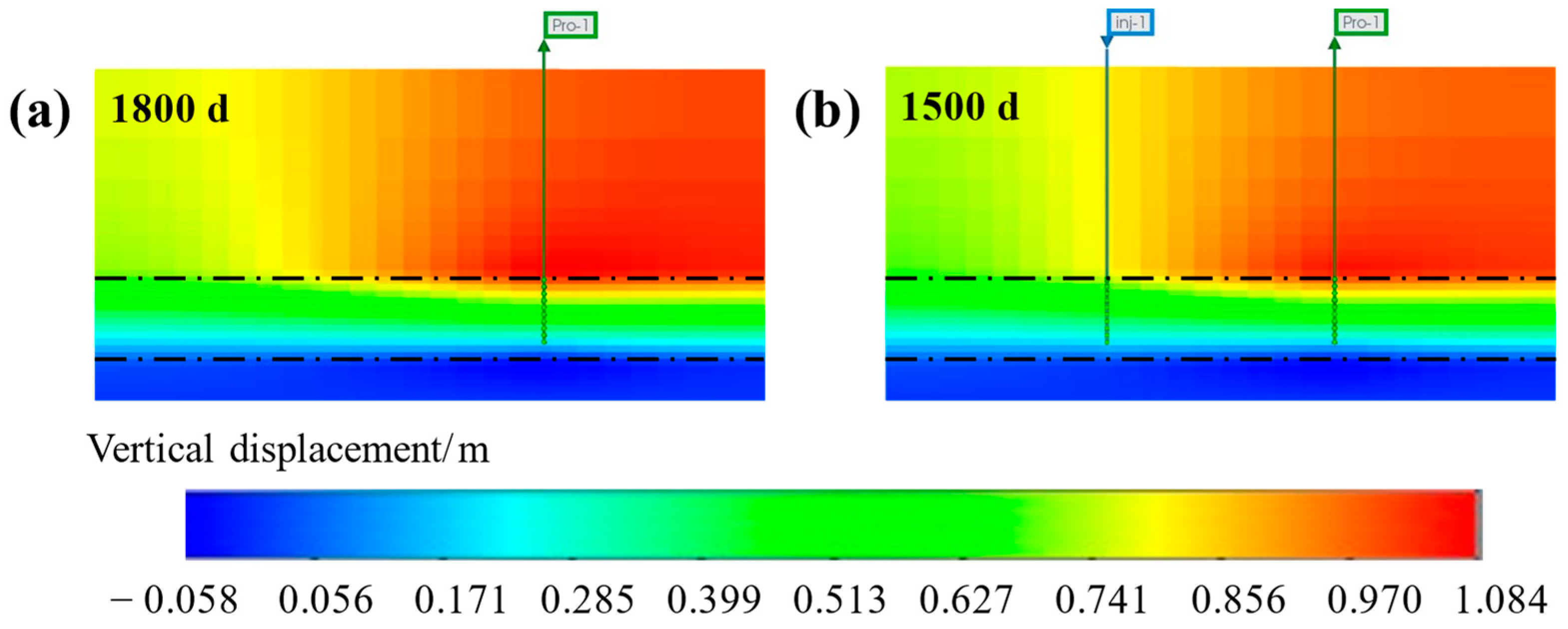
| Parameter & Unit | Value | Parameter & Unit | Value |
|---|---|---|---|
| Grain density/(kg·m−3) | 2650 | NGH layer temperature/℃ | 15.15 |
| Intrinsic permeability of overburden/(10−3 μm2) | 1 × 10−6 | Pressure of hydrate layer/MPa | 15.23 |
| Intrinsic permeability of NGH layer/(10−3 μm2) | 1100 | Relative permeability index n | 3.572 |
| Intrinsic permeability of underburden/(10−3 μm2) | 1 × 10−6 | Irreducible water saturation SirA | 0.30 |
| Porosity of overburden | 0.10 | Residual gas saturation SirG | 0.015 |
| Porosity of NGH layer | 0.38 | Young’s modulus of the matrix/MPa | 300 |
| Porosity of underburden | 0.10 | Young’s modulus of the natural gas hydrate/MPa | 500 |
| Initial hydrate saturation in NGH layer | 0.50 | Young’s modulus of the CO2 hydrate/MPa | 800 |
| Water saturation in NGH layer | 0.50 | Poisson’s ratio | 0.3 |
| NGH density/(kg·m−3) | 920 | Friction angle | 30° |
Publisher’s Note: MDPI stays neutral with regard to jurisdictional claims in published maps and institutional affiliations. |
© 2022 by the authors. Licensee MDPI, Basel, Switzerland. This article is an open access article distributed under the terms and conditions of the Creative Commons Attribution (CC BY) license (https://creativecommons.org/licenses/by/4.0/).
Share and Cite
Li, Q.; Li, S.; Ding, S.; Yin, Z.; Liu, L.; Li, S. Numerical Simulation of Gas Production and Reservoir Stability during CO2 Exchange in Natural Gas Hydrate Reservoir. Energies 2022, 15, 8968. https://doi.org/10.3390/en15238968
Li Q, Li S, Ding S, Yin Z, Liu L, Li S. Numerical Simulation of Gas Production and Reservoir Stability during CO2 Exchange in Natural Gas Hydrate Reservoir. Energies. 2022; 15(23):8968. https://doi.org/10.3390/en15238968
Chicago/Turabian StyleLi, Qingping, Shuxia Li, Shuyue Ding, Zhenyuan Yin, Lu Liu, and Shuaijun Li. 2022. "Numerical Simulation of Gas Production and Reservoir Stability during CO2 Exchange in Natural Gas Hydrate Reservoir" Energies 15, no. 23: 8968. https://doi.org/10.3390/en15238968
APA StyleLi, Q., Li, S., Ding, S., Yin, Z., Liu, L., & Li, S. (2022). Numerical Simulation of Gas Production and Reservoir Stability during CO2 Exchange in Natural Gas Hydrate Reservoir. Energies, 15(23), 8968. https://doi.org/10.3390/en15238968








